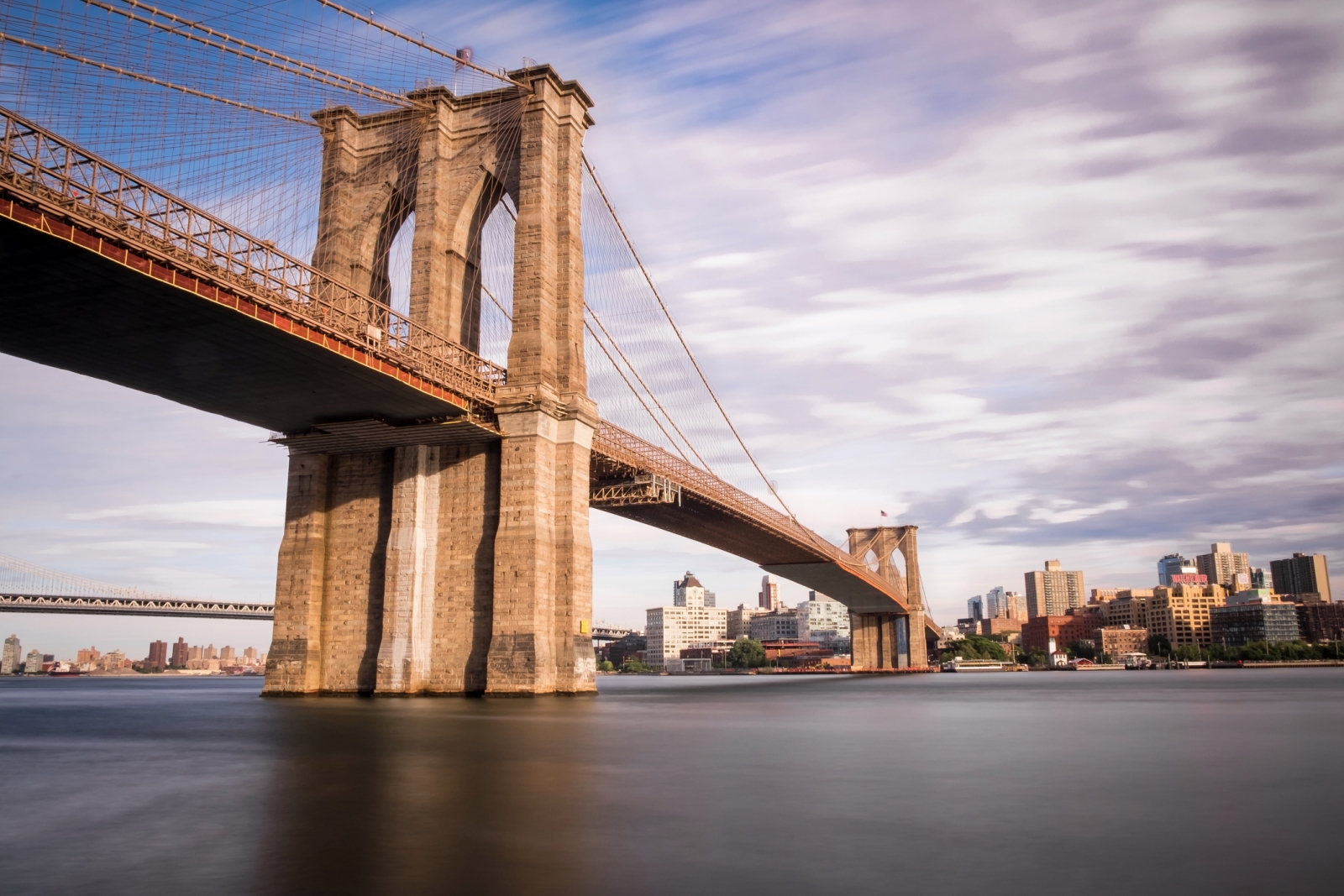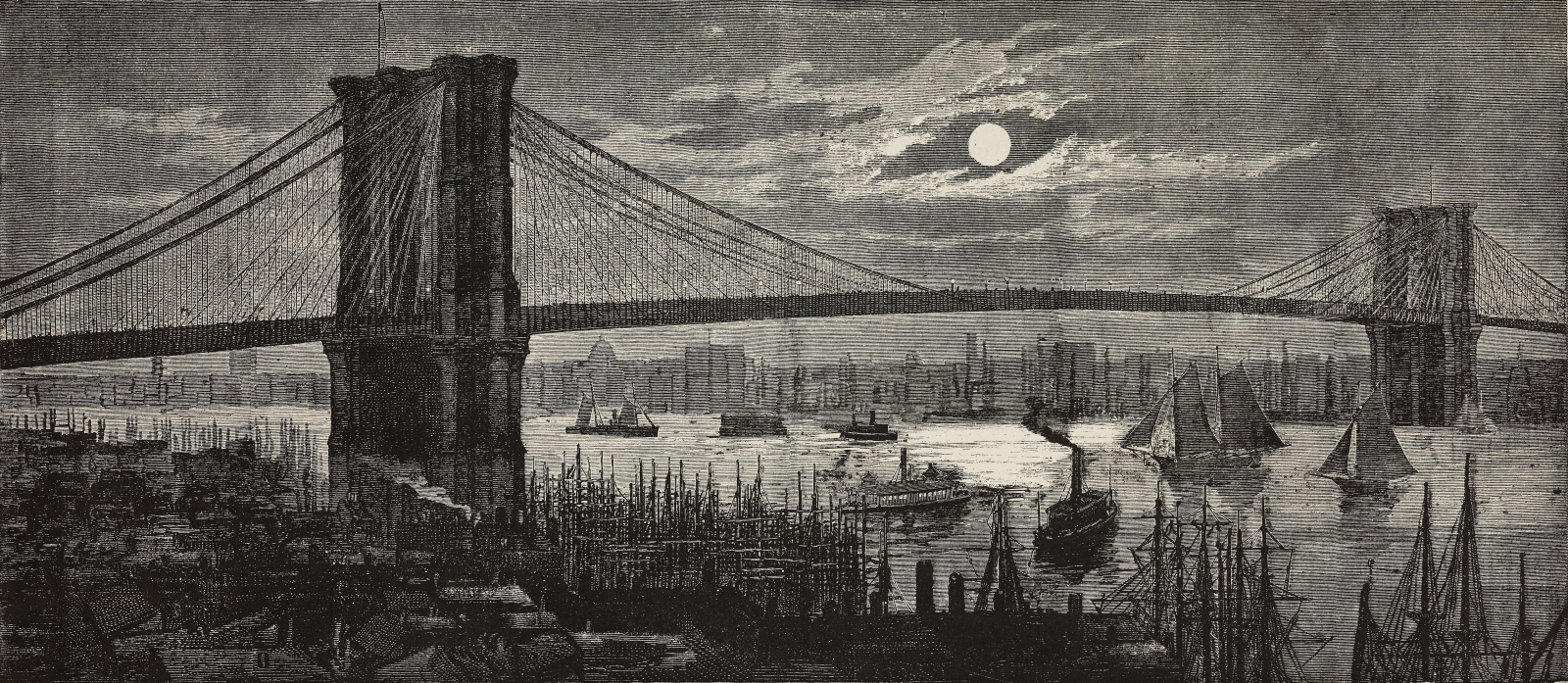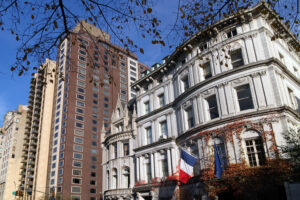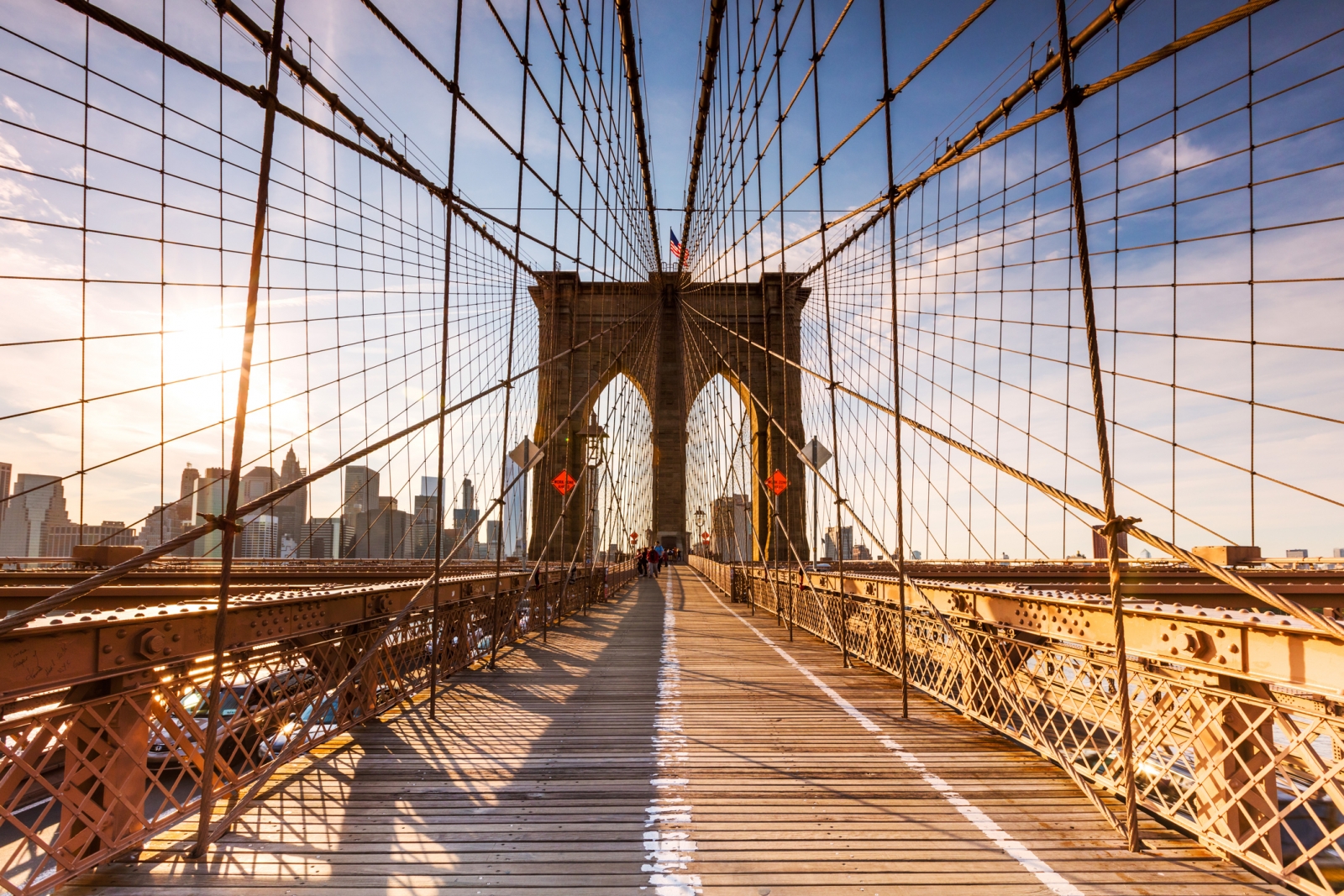
A rare moment of quiet on the pedestrian walkway of the Brooklyn Bridge. Everyone knows the bridge — but do you know its amazing backstory?
The Brooklyn Bridge, constructed between 1870 and 1883, is perhaps the most storied and most famous bridge in the world. With a main span of 1,595.5 feet, it was the longest suspension bridge in the world from its opening until 1903, and the first steel-wire suspension bridge ever built.
The bridge remains an essential stop for all New York City sightseers, who stroll its pedestrian path between Manhattan’s Civic Center and the charming residential enclave of Brooklyn Heights. The Brooklyn Bridge changed New York forever when it was built, and remains an essential transport link today. But whose idea was it, and how did it get built? Read on for the incredible tale of how the Brooklyn Bridge came to be — and what it’s like today.
History of the Brooklyn Bridge
Brooklyn Bridge architect John Roebling (1806-1869) was born in Mühlhausen, Prussia. Though he had humble beginnings, his mother recognized his keen intelligence and sent him to Berlin to study architecture and engineering. In 1831, with his brother Carl, Roebling moved to western Pennsylvania, founding a farming community called Saxonburg. (His house in Butler County still stands.) After the agrarian colony failed, Roebling turned back to engineering.
Even by the middle of the 19th century, there were few bridges over major rivers; goods were floated across on barges, and people rode ferries. In 1841, Roebling began producing wire rope strong enough to support bridge roadways, and was hired to produce a number of river crossings, the first over the Monongahela River in Pittsburgh in 1845. After a number of successful commissions, he built a large wire rope plant in Trenton, New Jersey.
In the following decade, Roebling designed a railroad bridge over the Ohio River between Cincinnati, OH, and Covington, KY, which resembles a smaller version of the Brooklyn Bridge. He first conceived of the Brooklyn span in 1852, but it took him more than 15 years to secure approvals for it, as the Civil War, among other occurrences, sapped capital and materials. Such a crossing was becoming crucial, because in that era, winters were colder, and barges and boats found the ice-choked river difficult to navigate.
In 1867, aided by a particularly harsh winter, Roebling enlisted the aid of prominent businessman William Kingsley and state Senator Henry Murphy (The “Senator” of Bay Ridge’s Senator Street). After two years of negotiations with the city and state, the East River Bridge was approved in 1869. Fully 14 years of construction commenced. John Roebling died from a tetanus-infected wound at a pier accident that year, at the age of 63. But his son, Washington, working from voluminous notes his father had produced, completed the project.
Building the Bridge
Much of the initial work on the bridge was done in the riverbed, where the foundations of the bridge towers were built using caissons — large airtight boxes or cylinders in which men, breathing compressed air, dug the foundations, ultimately anchored to the bedrock. It was dangerous work. Washington Roebling personally supervised the workers until he contracted caisson disease, or the bends, and then oversaw construction from his home in Brooklyn Heights, relaying commands via Morse code to his wife, Emily, who herself had studied advanced mathematics and bridge engineering.
Within five years, the tower foundations and towers themselves were complete. The most difficult work was just beginning, as hundreds of miles of steel cables strong enough to support 160,000 pounds per square inch needed to be woven. After the last cable was positioned in 1878, a taxpayers’ lawsuit, charging that the bridge was unsound, threatened the entire project. The case dragged on for several months, and Washington Roebling agreed to the addition of stiffening trusses. The last element, the roadway, was finally built from the foundations to the towers, supported by the cables, and the bridge opened to traffic on May 24, 1883.
Walking the Brooklyn Bridge
The Brooklyn Bridge walkway is nearly de rigueur for NYC visitors and tourists, though every New Yorker should walk the length of the span at least once. A unique perspective of the Manhattan skyline is available from the wood-planked walkway, which runs between the vehicular roadways on each side.
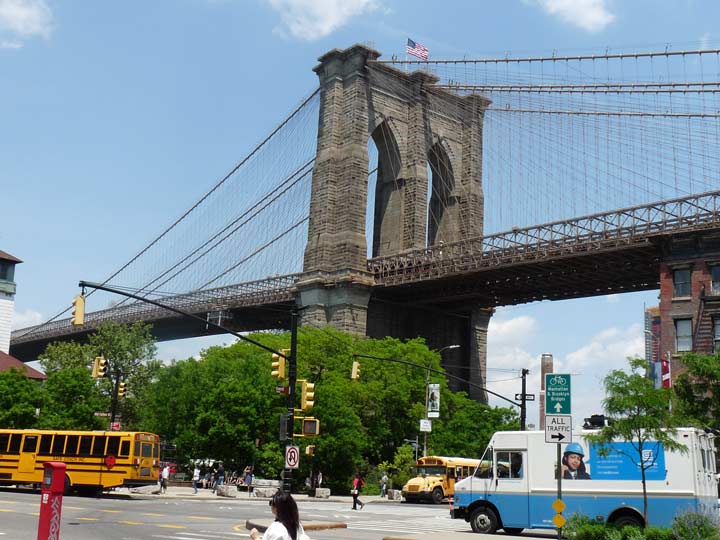
The Brooklyn Bridge checks off several “first” and “only” boxes. It was the first major bridge to cross the East River; it’s the only NYC bridge with masonry-clad towers made of limestone, granite and Rosendale cement, a more durable mortar produced in Ulster County, NY. Its successors, the Williamsburg, Manhattan and all other major bridges reveal their steel skeletons (though the George Washington Bridge was originally planned with brick coverings on its towers). For many years, it was also the only major NYC bridge featuring diagonal suspension cables, though in recent years the cable-stayed Kosciuszko and Goethals Bridges have employed diagonal cables.
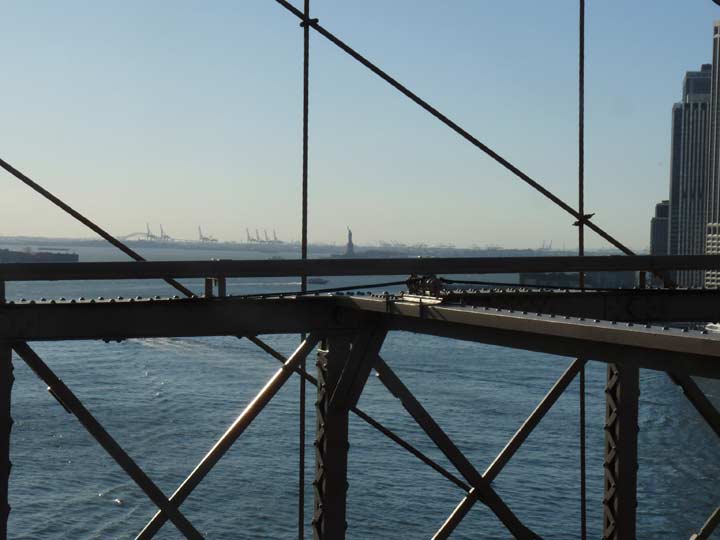
The Manhattan skyline isn’t the only available vista. Looking south across Upper New York Bay reveals Lady Liberty, the container vessel cranes on the Bayonne shore, and the Bayonne Bridge.
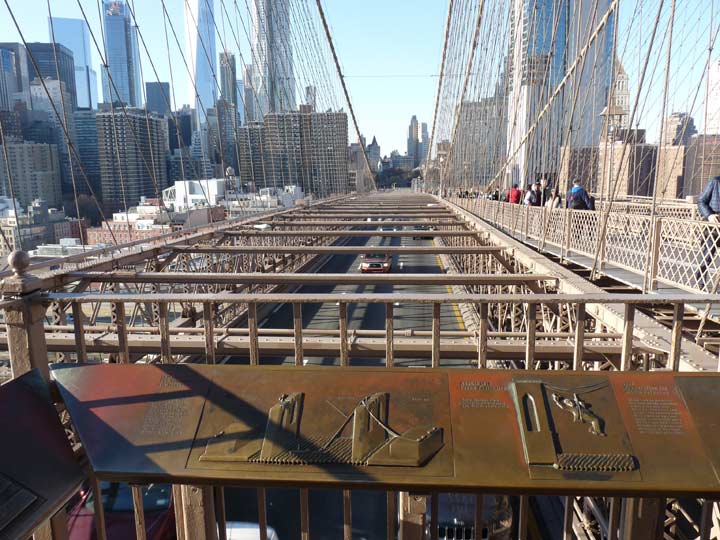
Maintaining the Bridge
At the two masonry towers, the walkways detour over the roadways and provide a look at the roadways beneath them. The bridge is not immune from graffiti that has to be scrubbed off from time to time. It had become a tradition for people to place padlocks on the cables to profess love and affection. Unfortunately, all that metal added weight to the bridge and risked destabilizing it, hence their removal. The bridge’s cables and other aspects are constantly checked for safety. Shortly after the bridge opened in 1883, a rumor spread like wildfire among bridge walkers that it was collapsing, and the resulting stampede caused over a dozen deaths. No such collapse was happening, of course.
The metal braces over the roadways, which strengthen the bridge’s integrity, were added in 1948 by engineer David Steinman, who assisted with the Hell Gate Bridge and designed the Henry Hudson Bridge connecting Manhattan and the Bronx at the Harlem River.
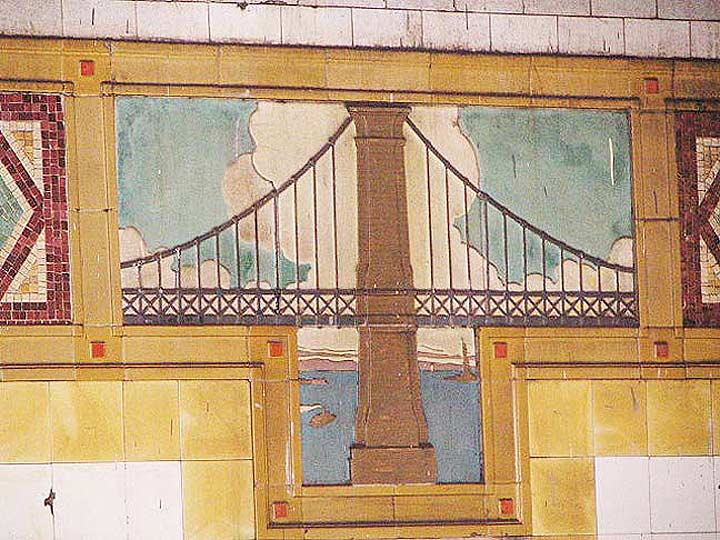
The Brooklyn Bridge in the Chambers Street Subway Station
The Chambers Street station, completed in 1913, was originally going to be part of a loop line that would connect the Williamsburg and Brooklyn Bridges with a line through Manhattan. The Brooklyn Bridge connection was never built, but the bridge is depicted on plaques in the station, which reminds us of the former grand plan.
A close look at the plaque reveals an error made by designers George Heins and Christopher LaFarge. The Brooklyn Bridge in the plaque doesn’t have any of the distinctive diagonal cables that are its trademark. The reason they were left out is unclear; the plaque is actually four separate small plaques that were seamlessly put together to make one.
On the plaque, we are looking south from the Manhattan tower. The Statue of Liberty can be seen indistinctly in the distance — a measure of the detail artists and designers employed in the execution of the plaque.
Kevin Walsh is the webmaster of the award-winning website Forgotten NY, and the author of the books Forgotten New York (HarperCollins, 2006) and also, with the Greater Astoria Historical Society, Forgotten Queens (Arcadia, 2013)
—
Hey, why not like StreetEasy on Facebook and follow @streeteasy on Instagram?

